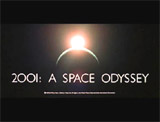
|
2001:
A Space Odyssey (1968, UK)
In Stanley Kubrick's influential, profound, visionary
and awesome, genre-defying sci-fi masterpiece - a landmark, astounding
science fiction classic - and probably the best science-fiction film
of all time about exploration of the unknown; it was an epic film
that contained more spectacular imagery (about what space looked
like) and special effects than verbal dialogue. Kubrick's sci-fi
experiment intended to present its story almost purely with visual
imagery and auditory signals with very little communicative human
dialogue.
The breathtaking, richly eloquent, and visually-poetic
film - deliberately filmed at a slow pace - about the evolution of
humanity, space travel, and the discovery of extra-terrestrial intelligence
(many years before Star Wars (1977),
Close Encounters of
the Third Kind (1977), and E.T.: The
Extra-Terrestrial (1982)), was based on the published 1951
short story The Sentinel, written in 1948 by English science
fiction author Arthur C. Clarke. Its original screenplay was co-authored
by director Stanley Kubrick and Clarke from an expanded novelization,
and the film was originally titled Journey Beyond the Stars.
A sequel was made years later: director Peter Hyams' 2010
(1984) (from a 1982 published adaptation titled 2010: odyssey
two by Clarke).
- in the opening visual image, the camera panned upward
from the pock-marked surface of the Moon in the foreground; the
perspective was from behind the Moon; in the distance was a view
of the Sun rising over the Earth-crescent in the vastness of space;
the image showed the heavenly bodies of the Earth, Moon, and Sun
in a vertically-symmetrical alignment or conjunction; the opening bold
trinitarian chords [C, G, and again C] of Richard Strauss's Also
Sprach Zarathustra accompanied and welcomed this striking shot
of orbital and visual alignment; the credits then followed
- in the first of the film's four major episodes (three
were given titles) - "The Dawn of Man" episode
- numerous man-apes' tableaux scenes were set in prehistoric
Africa in the Pleistocene era - four million years ago (4,000,000
BC); the prehistoric herbivorous ape-men were vegetarians who foraged
for grass and roots; they had not developed the tools or
weapons necessary to attack and kill or eat the tapirs like other
predators
- at dawn, the apes were awakened to an eerie humming
sound; the apes confronted the film's first mysterious and alien
black monolith - [Note: In Arthur Clarke's novel, the mysterious
monolithic stone slab was a technological machine belonging to
aliens in space, one of hundreds of such monoliths sent to Earth
to test, teach and transform the apes into higher-order, intelligent
beings.] The apes herded and gathered around it and huddled by
it, reaching out to touch it, just as another celestial alignment
or configuration occurred; with the mysterious monolith in the
foreground, the glowing Sun rose over the black slab, directly
beneath the crescent of the Moon

Ape-Man Leader (Daniel Richter) Reacting to Eerie Humming Sound
at Dawn
|

Apes Surrounding An Alien Black Monolith and Touching
The Object
|

At The Moment of Celestial Alignment
|
- in a slow-motion sequence
during the alignment - accompanied by the slowly-building tone
of Strauss's Also Sprach Zarathustra - the primeval leader
ape-man (Daniel Richter) picked up an animal bone and used it to
smash at and shatter a skeleton on the ground; it was a major evolutionary
breakthrough - he would now be able to hunt for food and kill a
tapir with his new utilitarian tool; in a sense, he became endowed
with intelligence, and transitioned to a higher and more dominant
order (as a carnivorous being) with the ability to reason and the
power to use tools to survive and gather food

|

|

|

|
|
Apes Learning to Use Bones As Tools
- To Kill Tapirs and Become Carnivorous
|
- the next day at the waterhole to take control, the
intelligent, domineering, carnivorous man-apes drove
off the weaponless (and tool-less) neighboring creatures with their
newfound strike power provided by bone-weapons - it was the first
instance of warfare with the use of the bone as a club to attack,
crush an opponent's skull and kill
- afterwards, the victorious, exuberant and triumphant
ape-man leader - in slow-motion - tossed his fragmented skeletal
bone-weapon into the air; it flew and spun upwards, twisting and
turning end-over-end; there was a marvelously audacious, seamless
transition/edit from the bone-weapon into a futuristic, Earth-orbiting
space satellite - one of the most famous jump-cuts in cinematic history
- moving ahead four million years; the space object was another technological
instrument, tool, weapon (orbiting nuclear platform) or machine from
another era [Note: The toss of the
ape-man's bone was metaphoric for a lift-off from Earth toward the
Moon, and for the tremendous technological advances that had occurred
in the interim]

Using the Newfound Bone Weapon to Dominate Rival Creatures
|

The Triumphant and Victorious Ape Leader Tossing
His Bone-Weapon Into the Air
|
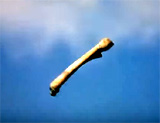
|

|
|
The Jump Cut From the Skeletal Bone-Weapon to a Rectangular
Space Satellite
|
- in space between the Earth and the Moon in the year
2001, miniature models of spacecraft satellites (one rectangular
and one cylindrical) were portrayed against the black, immense quiet
and visual, weightless spendor of outer space; also, a winged, arrow-shaped
Pan-Am space shuttle (named Orion) soared toward the
Moon, bound first to stop at a circular, wheel-shaped Space Station
5 - a way-station for passengers traveling onto the lunar surface,
to the accompaniment of Johann Strauss' waltz Blue Danube
- in the weightless environment of the shuttle, the
sole passenger American scientist Dr. Heywood Floyd (William Sylvester) slept as the shuttle slowly
docked with the gigantic circular Space Station 5; after docking and
entering the space-station interior (the Orbiter Hilton), Dr. Floyd
phoned his home with a Bell Picturephone to wish his daughter Squirt (director Kubrick's
daughter Vivian) a happy birthday

Inside the Ultra-Modern Space Station 5
|

Dr. Floyd's Birthday Phone Call to His Daughter
|

Dr. Floyd Speaking to Curious Soviet Scientists
|
- Floyd's ultimate destination - during a top-secret
mission - was to the American moon-base
on the Moon's crater of Clavius; while awaiting the next leg of his
trip during a brief meeting with Soviet scientists, Dr. Floyd deflected
questions and concerns about "odd things" occurring
at the US outpost on the Moon (and rumors of an epidemic)
- he continued on his journey via a spherical Aries lunar
landing craft; there were two astounding visuals during the weightless
flight - an attendant in a rotational elevator, and the humorous "Zero
Gravity Toilet"; after landing on the lunar surface, Dr. Floyd
spoke to other scientists in a conference board room about their
"significant discovery" - a second monolith (a twin to the
first one) unearthed on the surface of the moon at the crater, but
declined offering details about the false "cover story" regarding
a possible epidemic at the base
- Floyd's next vehicular craft was a Moon Bus that took
him to the Tycho crater excavation site during the lunar dawn; in
the crater-pit on the Moon at the Clavius Moon Base (a lunar settlement),
space-suited scientists viewed (and touched) a brightly-lit second
monolith (a Tycho artifact), that had supposedly been buried four
million years earlier; Dr. Floyd reached out and touched the monolith
with his thick glove; as the scientists were having their picture
taken, a ray of sunlight struck the monolith
- signaling the end of the dark, 14-day lunar night

|

|
|
Discovery of Excavated Monolith on the Moon Crater
of Clavius in the Year 2001, In a Giant Excavated Pit
|

Dr. Floyd Reaching Out and Touching the Monolith
|

Space-Suited Scientists Posing For a Picture In Front of the
Monolith
|
- there was another conjunctive orbital configuration
of the glowing Sun, Moon and Earth; the monolith emitted a deafening, high-frequency radio signal
directed toward the planet of Jupiter [Note: the signal from the
ancient civilization that buried it on the Moon was to alert mankind
that it was about to reach another more improved, advanced level
of consciousness and intelligence]
- the next segment
(the film's third major episode, titled "Jupiter Mission, 18 Months
Later")
fast-forwarded to 18 months later during a nine-month, manned voyage
of the spaceship Discovery One on
a one half billion-mile journey to Jupiter from Earth (launching in
the year 2002); its goal was to follow the path of the radio signal
and to find the origin of the alien culture that had planted the monolith
on the Moon and/or caused the unexplainable radio transmission
- on board the completely-automated spaceship was an
omniscient but faulty HAL 9000 computer (voice of Douglas Rain) identified
by an anthropomorphic 'red eye', and two astronauts who were not
in hibernation: Frank Poole (Gary Lockwood) and David Bowman (Keir
Dullea); three astronauts were also in cold-storage (cryogenic) suspended
animation; in fact, only HAL knew the real reason for the mission-trip
to Jupiter
- in the circular habitat of the crew in
the spaceship, Poole endlessly jogged and shadow-boxed around the
interior treadmill in a memorable image; the
emotionless astronauts appeared bored from the drudgery of their
technological routine, and the bland,
chemical space food (in a TV dinner type tray) and old video transmissions

Astronaut Poole Jogging Inside Discovery
|

Processed Meals and Video Transmissions
|

Poole Under a Sunlamp For a Sunbath
|

Poole's Electronic Chess Game Against HAL
|
- during the voyage, early in the year 2003, HAL 9000
expressed concern about "odd
things" in
the mission - a significant sign that the perfect mechanized
computer was possibly deteriorating, failing, or showing signs of
diminished responsibility (due to its knowledge of highly-classified
information) - and that the infallible computer was breaking down;
simultaneously, HAL informed the astronauts that a component of the
ship would soon malfunction in 72 hours, an AE35 antenna unit, and
it needed repair/replacement
- during an observational space-walk
trip in a small egg-shaped, one-man EVA (extra-vehicular activity)
space pod with long mechanical arms, astronaut Bowman during a spacewalk
replaced the defective Alpha-Echo-35 (AE35) communications unit with
a spare before it could fail, and returned to the main ship; he was
confused about HAL's warning since diagnostics showed the original
unit was not defective; even Mission Control in Houston reported
that preliminary findings indicated that HAL, the on-board 9000 computer
was "in
error predicting the fault"
- in one of the film's best scenes, the
astronauts decided to privately speak to each other in a sound-proofed,
sealed space pod, to be out of the computer's earshot; they discussed
how HAL had become unreliable and irrational regarding the faulty
AE35 antenna unit; HAL - represented by a big red eye, was revealed to
be malevolently eavesdropping on them by reading their lips,
in a marvelous, fast cross-editing sequence
- Bowman sent Poole out in the EVA to reinstall
the original A35 unit; if it didn't fail as HAL had predicted, HAL
would clearly be at fault and would be disconnected to prevent any continuing
flaws; while Poole was conducting the reinstallation during a spacewalk, HAL
deliberately severed his oxygen life-line with the mechanical clawed
arms of the space pod; Poole helplessly floated out into space - dead;
Bowman suspected that HAL was the faulty unit - and had engineered
the deadly "accident" in order to take over the spaceship

|

|
|
HAL Severing Poole's Oxygen Line
With Clawed Arms of Space Pod
|
- Bowman (carelessly without his spacesuit helmet)
again left the spaceship in a second pod in a vain attempt to rescue
Poole, who was already dead; meanwhile, the malevolent HAL - in order
to take control of the spaceship, also methodically murdered the
three hibernating crew members - with flashing warnings: COMPUTER
MALFUNCTION, LIFE FUNCTIONS CRITICAL, and then LIFE FUNCTIONS TERMINATED
- when Bowman returned in the pod to the closed entry doors,
HAL ignored Bowman's frantic attempts to re-enter the spaceship with increasingly-stern commands:
("Open the pod bay doors, HAL");
the icy-voiced, uncooperative, malevolent HAL justified his attempt
to kill the final living astronaut because of the threat of
disconnection, and because the astronauts ultimately threatened the
goal of the mission; to outwit the computer,
Bowman was able to daringly re-enter through the small, emergency air-lock
hatch by ejecting himself from the pod into the double-doored airlock
chamber, and then closing the doors
- to retaliate against HAL, Bowman took a slow
walk to the computer's reddish-toned "brain room" to slowly
debrain and disconnect the computer's core (a mechanical
lobotomy on the computer's logic and memory circuits); HAL
became suspicious ("Just what do you think you're doing, Dave?")
and pleaded: "I feel much better now. I really do"; one
by one, Bowman ejected components of HAL's auto-intellect panels (shaped
like tiny white monoliths) to reduce the computer to manual
control, while HAL calmly responded and protested
as he was slowly 'dying': ("Dave, stop. Stop, will you?
Stop, Dave. Will you stop, Dave? Stop, Dave. I'm afraid. I'm
afraid, Dave. Dave, my mind is going. I can feel it"); with slowed
and drugged speech as HAL's 'mind' deteriorated, he sang one of the first songs he ever learned
- Daisy, or A Bicycle Built For Two - in a child-like manner

|

|

|

|

|

|
|
Bowman Lobotomizing HAL-9000's Circuits
|
- as HAL disconnected and the spaceship approached Jupiter,
a pre-recorded televised briefing recorded prior to
the Discovery's departure (by Dr. Floyd) was triggered to play
- it provided crucial information about
the discovery of the monolith on the moon and
the true purpose of the Jupiter mission: "Eighteen
months ago, the first evidence of intelligent life off the Earth
was discovered. It was buried forty feet below the lunar surface,
near the crater Tycho. Except for a single, very powerful
radio emission aimed at Jupiter the four million year old black
monolith has remained completely inert, its origin and purpose
still a total mystery" -- in other words, the mission was to follow
the alien, high-frequency radio signal beamed directly to Jupiter from
the monolith found on the Moon and to explore the possibility of extra-terrestrial life
- in the film's fourth and final episode, "Jupiter
and Beyond the Infinite," astronaut Bowman continued alone on his
flight to Jupiter to find the life-force of the universe - he encountered
a third much larger monolith circling Jupiter amongst Jupiter's other
moons; the giant planet Jupiter (lit up as a bright crescent shape) and
its many moons, the spaceship Discovery,
and the Sun, were all lined up with this third monolith
- in a thrilling light-show ride activated by the monolith, Bowman left
the Discovery in a space pod to journey through both inner
and outer space as his pod was sucked into and sent racing down a
swirling vortex, corridor, or tunnel of speckles of colored light - it was the
ultimate trip through space and various landscapes ("the
Stargate") toward Jupiter and into another dimension; during
Bowman's passage, he was mysteriously
transfigured (or "reborn") into a higher form of intelligence
or universe of evolutionary life on his way to the alien planet

|

|

|

|

|

|
|
The Light-Show Stargate Sequence
|
- in an enigmatic and surrealistic sequence, the astronaut's
space pod landed and came to a halt somewhere beyond Jupiter in semi-familiar
surroundings created out of his own subconscious memories by the
aliens; it came to rest in a decorated, light-green and glacially-white
'cosmic bedroom' or ornate Victorian hotel suite/bedroom chamber;
Bowman emerged from the space capsule, and saw himself as he drastically
aged through various stages of life; he saw himself hunched-over,
wearing a dark dressing gown while dining at an elegant, table-clothed
cart in the middle of the room, and appearing as an elderly,
senile white-haired gentleman
- then in a final stage of life on his own deathbed,
the bedridden invalid Bowman looked toward the foot of his bed and
pointed at the film's fourth giant black monolith in the center of
the room; as he reached out, the camera moved toward the blackness
of the monolith and he was seemingly
reborn (or evolved and was transcended); he dissolved into a glowing,
hazy, translucent fetus or embryo in utero that rested on
the bed; a blast of the musical chords of Also Sprach Zarathustra -
signaling a decisive transformation - was heard for the last time

|
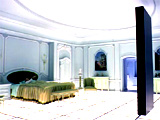
|
|
The Ornate Bedroom With the Monolith and an Aging
Bowman on His Deathbed, Pointing at the Monolith (4th)
|
- Bowman distinctly re-emerged within the embryo, with
his own serene and wise-eyed features as an ambiguous Star
Child; he was reborn as a cosmic, innocent, orbiting "Star
Child" that traveled through the universe without technological assistance
- the last enigmatic, open-ended image of the film was
of the large, bright-eyed (with pin-pointed, glowing stars for pupils),
luminous embryo in a translucent uterine amnion or bluish globe -
an enhanced, reborn superhuman floating through space above the Earth
in an orb of light, and the last stage of his cosmic evolution

|

|

|

|
|
Rebirth of a "Star Child"
|
|

Opening Visual Image: Conjunction of Moon, Earth, and Sun

Episode One: The Dawn of Man

Herbivorous Ape-Men Before Contact With a Monolith


Transition to Cylindrical Earth-Orbiting Satellites

Wheel-Shaped Circular Space Station 5
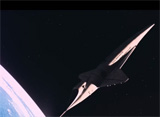
Needle-Shaped, Dart-Like Pan Am Shuttle Orion Soaring Toward
Space Station 5

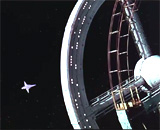
Docking of the Pan Am Shuttle in Space Station 5

Spherical Aries Lunar Landing Craft Soaring Toward the Moon

Attendant in Rotating Elevator

Zero Gravity Toilet



Landing of the Ares in a Domed Hangar on the Moon's Surface

Dr. Floyd Speaking to Assembled US Scientists in Conference Room of American
Moonbase

Moon Bus Transportation From the Moonbase to US Excavation Site

Another Orbital Conjunction of the Glowing Sun, Earth, and Moon

Film's Third Major Episode


Discovery 18 Months Later On a Mission to Jupiter

HAL-9000s Ubiquitous Glowing, Watchful Red Eye


Bowman's Space-Walk to Replace 'Defective' A35 Antenna Unit

HAL Observing the Testing of the Unit - Declared Not Defective

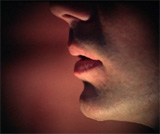
HAL Listening to Two Scheming Astronauts Through Lip-Reading

Bowman's Vain Attempt in a Pod to Rescue Poole in After His Oxygen Had Been Cut
by HAL

Hibernating Crew Members Killed by HAL
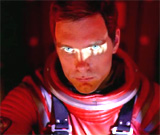
Bowman: "Open the pod bay doors, HAL"

Bowman Blasting Himself Back Into Air-Lock

Dr. Floyd's Pre-Recorded Video Message


On Bowman's Way to Jupiter - Another Alignment of the
Jupiter Planet and Its Moon, Sun, and 3rd Monolith

Pod Landed in Bedroom (An Observation Chamber?)



Bowman Gray-Haired and Aging
|







































